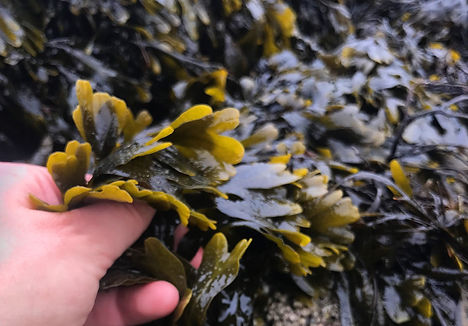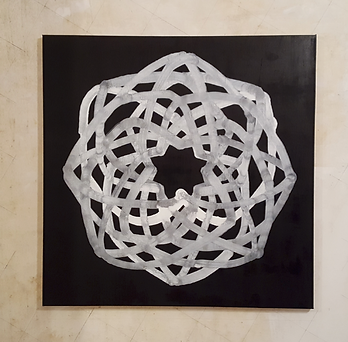Marie Cloquet
TRAVELING LIGHT
08/09/2019 - 20/10/2019
Marc Rossignol
Synchrone
Opening Sunday 9 September 2018
Marc Rossignol
Synchrone
Opening Sunday 9 September 2018
Marc Rossignol
Synchrone
Opening Sunday 9 September 2018
Marc Rossignol
Synchrone
Opening Sunday 9 September 2018
Herman Van Ingelgem
Foreign Bodies & Protheses
06/09/2021 - 17/10/2021
.jpg)
.jpg)

Sina Hensel
14th September - 2nd November 2025 Annie Gentils Gallery
Peter Benoitstraat 40, 2018 Antwerp
Foxes and pomegranates swimming in blue-green heat (2024–25) unfolds across three large wooden panels, their surfaces soaked in the indigo of European fields and the oceanic blooms of phycocyanin. Their burnt imagery is borrowed from The Lady and the Unicorn, six woven gardens, dreamt too peaceful for reality, born in medieval times on Flemish looms with production centres in Brussels or Bruges. The tapestries each personify a sense (sight, hearing, smell, taste, touch) through engagement between the lady, the unicorn, and the surrounding animals and plants, since in medieval thought the five senses were an essential means of understanding the human relationship with the world. The textiles’ colours themselves were the result of that relationality in the form of painstaking human and more-than-human labour: madder root for alizarin reds, weld for flavonoid yellows, pomegranate rind with iron salts for blacks, and woad indigo for blues. The wooden panels echo these material genealogies yet extend them seawards. By introducing phycocyanin, Hensel gestures towards the oceanic pigments of microalgae and cyanobacteria— the main companions in her ongoing PhD research. These organisms fix carbon, generate oxygen, and regulate the planet’s climate, reminding us that colour is not solely of the soil or terrestrial chemistry but also belongs to the oceanic microbial life that sustains the Earth.
Microcosm Moorings (2025), installed at the exhibition’s centre on the ground floor, continues this movement towards the sea or ocean. Small wooden structures reminiscent of footbridges, stained with phycocyanin, sit alongside ceramic-cast blood oranges grown by the sea in Southern Italy, and larger ceramics echoing the shapes of their peels. The anthocyanin pigments in blood oranges build up as a response to changing temperatures, as cold nights and warm days trigger their deep purple gradients. This question of how human and non-human organisms protect themselves from heat or sun extends across the smaller wooden panels. While microalgae, cyanobacteria, or blood oranges can shift colour as a protective mechanism, human attempts appear in the shape of a humble sunhat—an object conceived not only for ourselves but also for the organisms we value most. Upstairs on the first floor, small laser-burnt images depict a sea urchin covering her top with algae—another more-than-human protective gesture, assisting in camouflage and sun protection.
As the title Oceanic Gardens suggests, the exhibition also turns towards the rapid rise of liquid agriculture, as farms of cyanobacteria and microalgae spread across the globe. Like miniature forests of the sea, they similarly fix carbon and release oxygen. Their biomass feeds, fuels, and nourishes primarily human needs, while the drive for industrial scale often overlooks coastal communities and ecological networks already in place. In Proposal of Animal Architecture for Liquid Agriculture, this tension is rendered through structures inspired by the shapes of cat houses: relational layouts that remind us of the organisms’ entangled lives while asking us to reconsider the ways we culturally imagine, occupy, or name the seas.
Therefore, at the heart of the exhibition are kaleidoscopic more-than-human agents and their ecologies, while their colouring strategies are quiet responses to a changing climate. Here, colour is reconceptualised—not as the pretty colour-of-your-shirt, but as a survival technique, a warning
signal, a gesture of self-care, a red flag, a ghostly presence, an I-depend-on-you. Conceived as sites where environmental change becomes legible, these colour ecologies offer critical insight into the mutable signatures of a destabilising climate. Heat and warmth as practices of temperature and sunlight take part in shaping the works on a material level—and continue to do so even beyond the exhibition framework.
Sina Hensel is a visual artist and researcher with a special focus on critical colour practices, including the kaleidoscopic transformations caused by the current and future chemical make-ups of landscapes and environments. She studied painting at the Academies of Fine Arts in Karlsruhe and Hamburg, and in 2019 she graduated from HISK Ghent. Today, Sina is pursuing a PhD at the School of Arts Basel and the University of Art Linz, in collaboration with Humboldt University Berlin and KASK Ghent. From 2024–25, she is also a researcher in the Art & Ecology research group at the Royal Academy of Fine Arts Antwerp.
Her works have been shown at the 18th La Biennale di Venezia/IT, M HKA Antwerp/BE, Beursschouwburg Brussels/BE, PACT Zollverein Essen/GER, IKOB Eupen/BE, Albert van Abbehuis Art Center Eindhoven/NL, Cultural Center San Pedro de Atacama/CL, Kunsthalle Trier/GER, and CIAP Kunstverein Genk/BE, among others. Artistic residencies have brought her to Villa Empain Brussels/BE, Hangar Barcelona/ES, and La Wayaka Current Residency in the Atacama Desert/CL, among others.
List of works:
Foxes and pomegranates swimming in blue-green heat 1-3, 2024-25, European indigo and phycocyanin stained pine wood and gifted eucalyptus wood, laser-burnt engravings of images of the medieval tapestries ‘The Lady and the Unicorn’, each 240x122 cm
Microcosm moorings, 2025, Spirulina (Arthrospira platensis) harvested in Douarnenez on pine wood, laser-burnt engravings of prompts, cast blood oranges in red and black liquid clay from Westerwald, blood orange peels in red clay from Westerwald, seaweed ash and green sea glazes, dimensions variable
How to protect myself from the sun? 1-4, 2024-25, European indigo and phycocyanin stained pine wood, laser-burnt engravings, 59,8x29,7 cm
Proposal of animal architecture for liquid agriculture, 2025, white and black clay from Westerwald, indigo rain, night sky moth and birch glazes, Spirulina (Arthrospira platensis) harvested in Douarnenez, dimensions variable
Sea urchin covering her top with algae 1-8, 2025, European indigo and phycocyanin on pine wood, laser-burnt engravings, each 23,3x15,8 cm
This exhibition is realised with the kind support of Fablab iMAL–Art Center for digital cultures and technology Brussels, Goethe Institute Brussels, KIKK and Protolab & Medialab TRAKK Namur, CCN–Cultural Center Namur, .TheWorkshop, Kiwi Ceramic Workshop Brussels and RWTH Aachen University.
Sina Hensel
Oceanic Gardens

European indigo and phycocyanin stained pine wood and gifted eucalyptus wood, laser-burnt engravings of images of the medieval tapestries ‘The Lady and the Unicorn’, (Musée de Cluny – Paris) 59,8 x 29,7 cm Unique

European indigo and phycocyanin stained pine wood and gifted eucalyptus wood, laser-burnt engravings of images of the medieval tapestries ‘The Lady and the Unicorn’, (Musée de Cluny – Paris) 59,8 x 29,7 cm Unique

detail

Spirulina (Arthrospira platensis) harvested in Douarnenez on pine wood, laser-burnt engravings of prompts, cast blood oranges in red and black liquid clay from Westerwald, blood orange peels in red clay from Westerwald, seaweed ash and green sea glazes, variable dimensions

European indigo and phycocyanin stained pine wood and gifted eucalyptus wood, laser-burnt engravings of images of the medieval tapestries ‘The Lady and the Unicorn’, 240x122 cm

European indigo and phycocyanin stained pine wood and gifted eucalyptus wood, laser-burnt engravings of images of the medieval tapestries ‘The Lady and the Unicorn’, 240x122 cm



.png)
.png)

